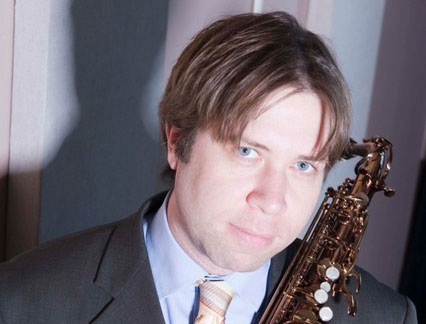A Chat with Saxophonist and Bjorkestra Bandleader Travis Sullivan

This article comes courtesy of guest contributor, Todd Feldman of RS Berkeley Musical Instruments.
Posi-Tone Records recording artist Travis Sullivan has earned a worldwide reputation as an alto saxophonist, pianist, composer, and arranger. He has been hailed by Jazz Times as being “…a gifted alto saxophonist and improviser who has also developed a strong and commanding voice as a composer.”
In 2002, his breakthrough came in the form of Travis Sullivan’s Bjorkestra, an 18-piece big band performing his arrangements of the renowned music of Icelandic pop goddess Bjork, and in 2008 he released Travis Sullivan’s Bjorkestra: Enjoy! on Koch Records. In 1999, he self-released Travis Sullivan’s Project One: As We Speak featured a quartet that included guitarist Rez Abbasi and drummer Ari Honig. In May 2011, Sullivan released his CD New Directions, his third album as a leader and his debut on Posi-Tone Records.
Sullivan has performed in the U.S. at venues such as The Blue Note, Iridium, The Jazz Standard, Joe’s Pub, and the SF Jazz Festival. He has also appeared internationally at The Montreal Jazz Festival, The Jarasum Jazz Festival (South Korea), and as a conductor for the Cologne Contemporary Jazz Orchestra (Germany), the Sicilian Jazz Orchestra (Italy), and the Reykjavik Big Band (Iceland).
His latest album, titled New Directions presents eight of his original modern jazz compositions, as well as Rodgers & Hart’s “Spring is Here,” and his arrangement of the Tears for Fears classic “Everybody Wants to Rule the World.”
The Interview
Travis, you have gained a worldwide reputation as an alto saxophonist, pianist, composer, and arranger. At what point does a musician begin to learn another craft, such as composing and arranging? While composing and arranging, what kind of role does your expertise in playing the saxophone have when producing your compositions and arrangements?
I think that you can start arranging and composing at any age. Mozart started doing it when he was three or so, so why not? The earlier the better.
I create my compositions and arrangements almost entirely at the piano, and my knowledge of the saxophone is very helpful when arranging for saxes, because I’m comfortable with the ranges and transpositions, as well as being able to better imagine what a line is going to feel and sound like when it’s played. Playing a wind instrument also helps with visualizing dynamics and articulation for brass and woodwinds, and serves as reminder that when writing melodic lines you can’t write a 16 bars of notes without accommodating for the player to take a breath.
At what age did you begin playing the saxophone and how did your education prepare you to become a professional musician? What would you tell a young musician aspiring to become a professional in terms of training, practice and being involved with different bands/orchestras/groups, etc?
I began playing the saxophone when I was ten. Although I enjoyed playing a musical instrument, I didn’t really think of it as a career option until I was a couple of years into my undergraduate studies in biochemistry at the University of New Hampshire. Up until that point I was taking private lessons with some excellent teachers, and they, along with my parents, helped me cultivate the discipline and passion for music necessary to be a professional, but it wasn’t until I was in college that I started being around a lot people my age that were serious about music and were considering it as a career. Ultimately, my education was ad hoc in a lot of ways until I decided to move to NYC to get my Masters at Manhattan School of Music, and then I was being presented a lot of material in a classroom setting. All that said, I think that there’s only so much you can learn about being a professional musician from the study and practice of music – there’s a whole other layer of experience that can only come from actually doing it, and so many of the important lessons that I’ve learned have come from being in bands, playing gigs, and interacting with my colleagues and friends.
My advice to young musicians aspiring to become a professional is to practice regularly and wisely, and have a teacher/mentor that you respect and can learn about all aspects of what it means to be a musician that goes beyond just the study of the instrument. Also – explore explore explore! Check out as many different styles of music that you can. Play in rock groups, jazz ensembles, big bands, wedding bands, classical orchestras. The sky’s the limit and it’s so important to keep your mind and ears open.
I notice you offer students the ability to study with you on your website, travissullivan.com. In your opinion, what would you say is the most common issues/problems you encounter while teaching saxophone to others? As a student yourself, what was the hardest thing you encountered with the saxophone and how did you overcome the problem?
Having students develop a solid concept of sound production on the saxophone is something that I’ve found to be the most challenging issue that I’ve encountered as a teacher and in my own studies. This is because there are so many physical factors that are at play in terms of embouchure, the throat, and breathing. This is made even more difficult because most students when they’re just starting out, understandably, don’t really know what they want to sound like on the instrument (or maybe if they even have a choice).
I struggled with this myself until I started studying with Dick Oatts at Manhattan School of Music. He’s an amazing saxophonist and teacher and for the first 4 months or so of working with him all we concentrated on was proper embouchure and sound production. It really required this intensive, focused work to overcome the issue of development of this concept.
As an educator, how do you guide your students in selecting the right instrument? What attributes do you look for in a saxophone and what is the best way to determine whether you’re playing the right brand/instrument?
I always suggest to my students that they get the highest quality instrument that they can afford. I think that the term “professional” saxophone is a little misleading, because since those instruments are generally higher quality, it follows that they’re actually going to be easier to play and to get a good sound on. Of course, budget needs to be a consideration, especially for a parent who is unsure whether or not their child is going to want to take lessons for more than a few months. For more advanced students that are looking to buy a new horn, I tell them to listen for tone and overall feel of the instrument, and to try out a lot of saxophones until they find the right one. Also, it’s very important to bring your teacher, parent or friend along when you’re trying out instruments, because it’s always great to get someone else’s opinion on how you sound.
How difficult is it to find the right set-up and how often should a student change their set-up? How important is it and why would a musician change their set-up to play different genres of music?
It takes a lot of experimentation to find the right set up, and I think how often a student should change their set up is a personal choice. As a teacher I’ll definitely advise a student to change their set-up if I’m hearing that it is either holding them back sound-wise – and that could either mean it’s too easy for them (the mouthpiece is too closed and/or the reed’s too soft) or too hard for them (the mouthpiece is too open and/or the reed is too hard). With that said, for beginners, I don’t think it’s a good idea to change one’s set-up too often, because at that point the student probably doesn’t have a solid concept of sound production to begin with, and changing the setup may complicate matters of embouchure development. Once a student reaches an intermediate level of study, this may be a better time for experimentation – even if they’re happy with what they already have. There might be something out there that is better for them. Of course, some players get addicted to this sort of experimentation. I’m not one of them personally, but I see the appeal.
You’ve certainly worked on some very successful projects, most notably when your breakthrough came in the form of Travis Sullivan’s Bjorkestra, an 18-piece big band performing your arrangements of the renowned music of Icelandic pop goddess Bjork, As a working musician, how do you decide to take on a project of this magnitude? What made you decide to rearrange the music of Bjork versus others?
At the beginning of working on this project, I didn’t think that it was going to develop into the huge undertaking that it became. I was listening to a lot of Bjork’s music in the late 90’s/early 00’s and thought that her music was fertile ground for improvisation and large ensemble writing – her melodies, harmonies, and grooves are beautiful, and there are plenty of counter-melodies and sound layers to orchestrate. The bottom line is I loved her music and wanted to explore it deeply.
I also wanted to learn more about writing for big band at the time. When I completed the first arrangement “Hyperballad,” I decided to write another, and sometime during the writing of the second arrangement I had the idea to write an entire “song cycle” for big band and vocals, with Bjork’s music as the core of the work. It happened all very organically, and had nothing to do with making a decision of one artist or another, it was only about the writing and exploration at that point. In fact, I had about four or five arrangements written before I had the idea to name the band The Bjorkestra.
This project has had the type of success creatively and professionally that I still haven’t figured out how to duplicate with my other projects, but am certain that it has something to do with having absolutely zero expectations about the outcome, and being 110% engaged in the process of creation.
At what point should/would a saxophonist begin to incorporate playing other types of saxophones (tenor/baritone/soprano/sopranino)? Why do you think the alto saxophone is the preferred choice for novice players versus something smaller like a soprano?
Once a saxophonist has developed a basic proficiency and a solid embouchure on their starting instrument, it’s OK to incorporate other types of saxophones. I started on the alto saxophone, and in junior high school I ended up playing baritone saxophone in concert band and absolutely loved it! It can’t hurt for a young student to be exposed to assuming different roles in ensemble settings.
I think that alto saxophone (and sometimes tenor) is the preferred choice over soprano because of embouchure, intonation, and concert band orchestration. Playing in the high register on soprano is really tough for a beginner, as well as developing a solid yet relaxed embouchure. As a consequence, it’s rare that you’ll see soprano sax parts written for student concert bands, which already have a balance issue when you have eight alto saxophonists vs. the generally quieter flutes and clarinet. All in all, the alto saxophone is the path of least resistance for both music educators and the young beginner.





